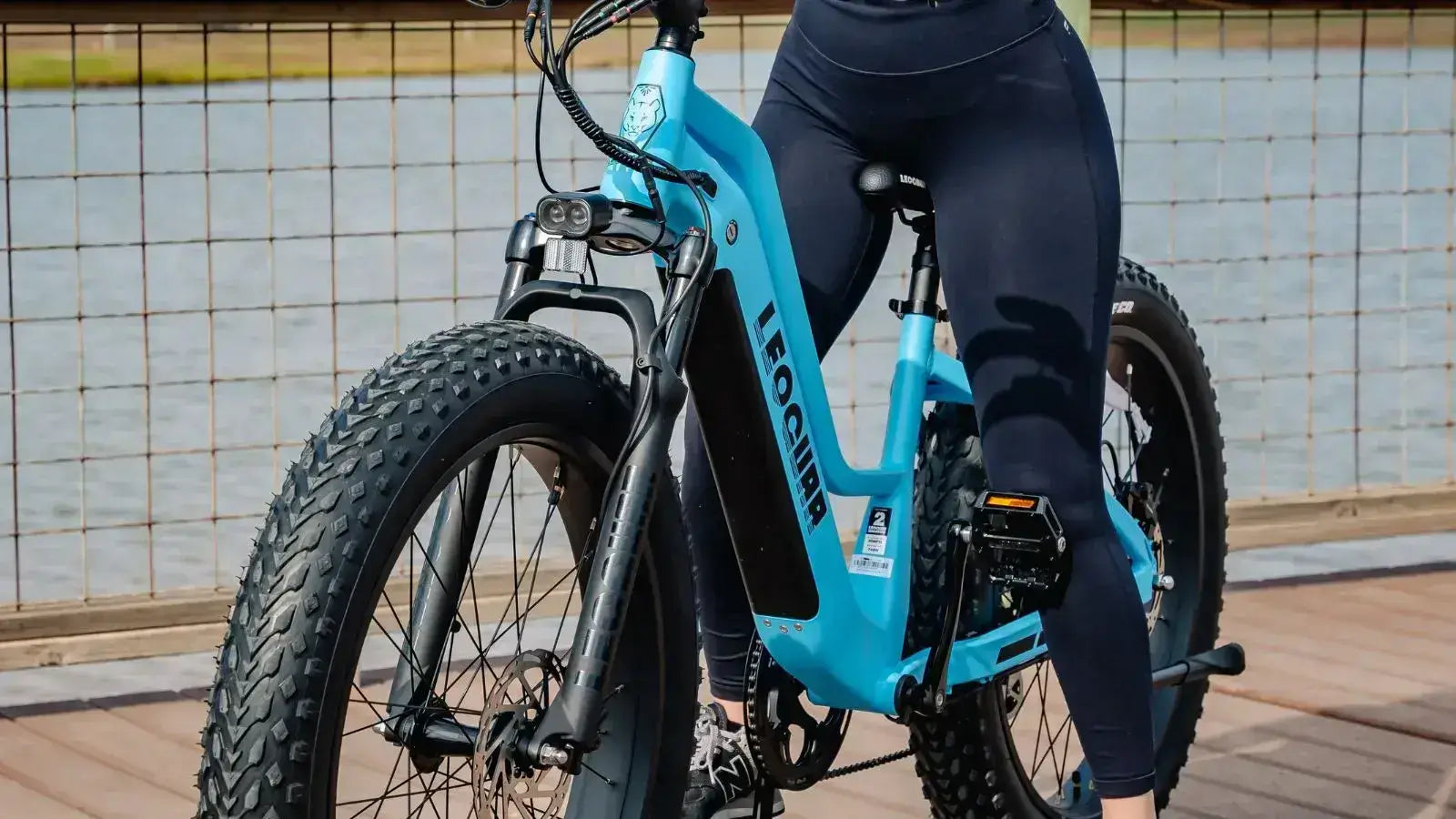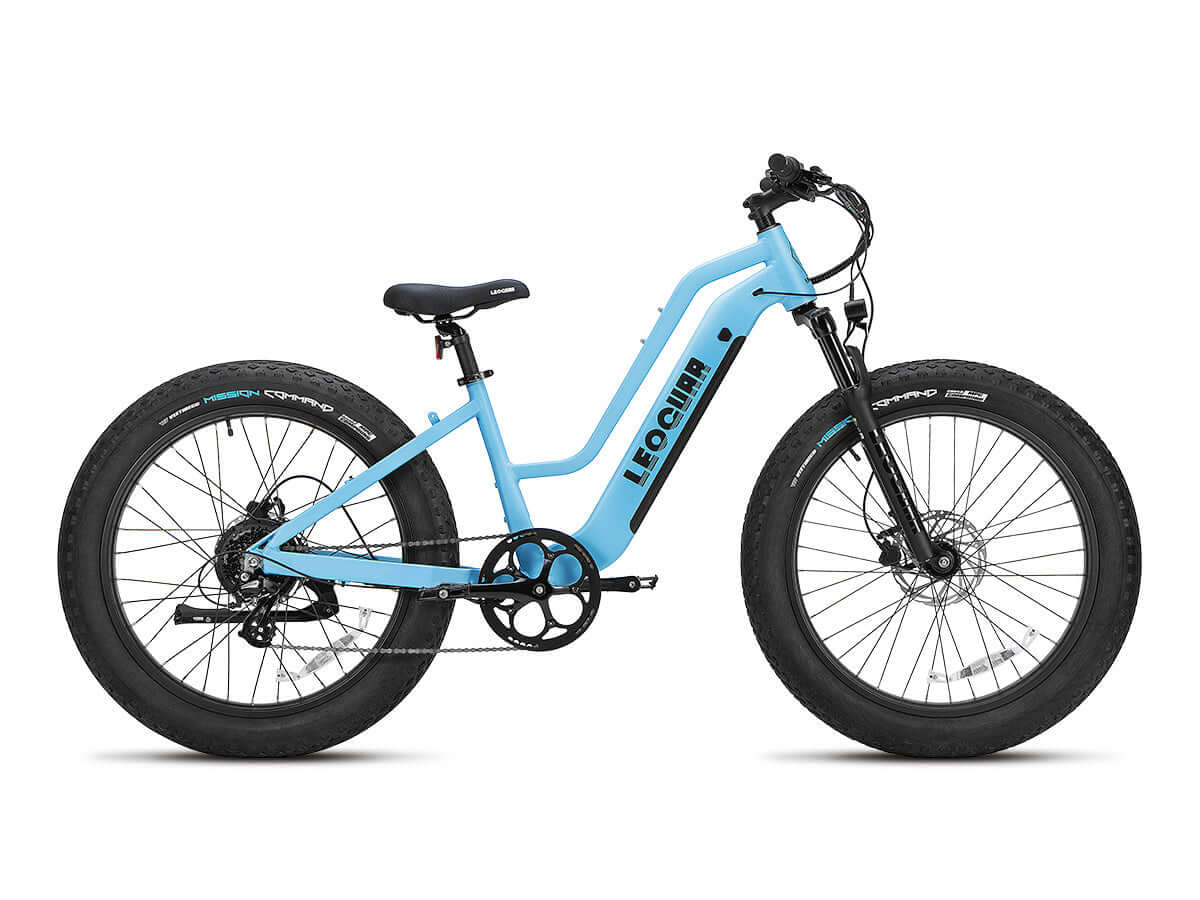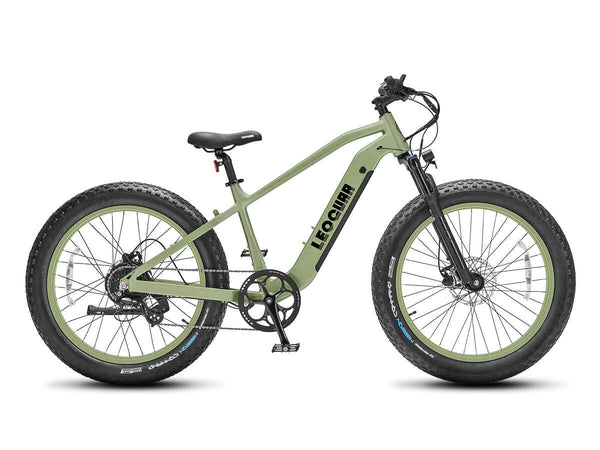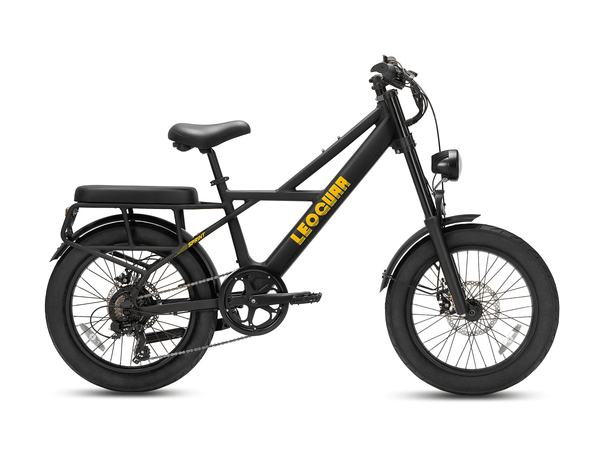
What Are Fat Tires on Bikes For—and Should You Get a Fat Tire Electric Bicycle?
You've probably seen them before. Bicycles with huge, almost cartoonish tires roll down trails or city streets, turning heads wherever they go. These are fat tire e bicycles. Those massive tires are far from just a style choice. They are purpose-built tools designed to provide amazing traction and a unique feature called "float." This lets them glide over soft, unstable surfaces like snow, sand, and mud, where regular bike tires would sink and spin uselessly. They are the monster trucks of the cycling world. These bikes are built to conquer terrain that stops other bikes in their tracks.
In this guide, we'll dive deep into what a fat tire bicycle is and what it does best. We'll also look at its trade-offs. Then, we'll explore how adding an electric motor changes everything and help you decide if a fat tire electric bicycle is right for you.
What Makes Fat Tires Different: The Power of a Wider Footprint
The massive "footprint" of its tires is at the heart of a fat bike's ability. This isn't just about looking tough. It's a smart design choice based on physics. The size and pressure of the tire are the two key elements that give it these unique properties.
Defining "Fat"
To understand what makes a fat tire "fat," it helps to compare it to more common bike tire sizes. The difference is not small. It is a major shift in scale that changes what a bicycle can do.
| Tire Type | Typical Width Range | Typical Pressure (PSI) |
|---|---|---|
| Fat Tire | 3.8 – 5.0+ inches | 5 – 15 PSI |
| Mountain Bike Tire | 2.1 – 2.6 inches | 25 – 45 PSI |
| Road Bike Tire | 25 – 32 millimeters | 80 – 120 PSI |
It's also worth noting that not all wide tires qualify as true "fat tires." Many urban or hybrid e-bikes feature tires around 2.1 to 2.4 inches wide, which provide some cushion and grip, but they don't deliver the same float or off-road capability as tires in the 3.8 to 5.0+ inch range. These in-between tire widths can be a good compromise for riders seeking comfort without the added drag of full-size fat tires.
As the table shows, a fat tire is much wider and runs at a fraction of the air pressure of a standard tire. This low pressure is not under-inflation. It is the key to unlocking the tire's performance.
The Science of Float
The combination of a wide profile and low pressure creates a large "contact patch." This is the area of the tire touching the ground at any given moment. This is where the magic happens. We can explain this with a simple comparison: think of the difference between walking in deep snow with boots versus snowshoes. The boot, with its small surface area, sinks with every step. The snowshoe, however, spreads your weight over a much larger area, letting you "float" on top of the snow.
A fat tire does exactly the same for your bike. On soft surfaces like sand or snow, the tire bends and spreads out, greatly increasing the contact patch. This prevents the bike from digging in and instead allows it to glide over the surface. This provides a level of mobility that is simply impossible on narrower tires.
Adjusting your fat bike tire pressure is one of the easiest ways to improve performance on different terrain. On soft surfaces like snow or sand, lowering your PSI to around 5–8 helps increase float and traction. For firmer conditions like dirt trails or gravel, 10–12 PSI offers better efficiency and control. If you’re riding on pavement or hardpack, inflating to 14–15 PSI reduces rolling resistance without sacrificing too much comfort. Always consider your weight, terrain, and ride style when dialing in tire pressure—it makes a big difference.
What Are Fat Tire Bikes Best For? Terrain-Specific Advantages
A fat tire bicycle is a specialist tool. While you can ride it almost anywhere, its true purpose is to open up new frontiers and extend the riding season into conditions that would stop most cyclists.
Unmatched Grip
The massive contact patch and aggressive, knobby tread patterns work together to deliver incredible traction. The tire conforms to the ground's surface, wrapping around rocks, roots, and loose gravel to maintain a secure grip where other bikes would slip and slide. This makes them supreme on specific terrains.
- Snow: This is the original and most celebrated use case. Fat bikes turned winter from an off-season into a prime riding season, allowing cyclists to explore snow-covered trails and frozen landscapes.
- Sand: From cruising along a hard-packed beach at low tide to tackling sandy desert trails, fat tires provide the float needed to power through without getting stuck.
- Mud: Wet, sloppy conditions that would clog and stop a mountain bike are often no match for a fat bike. These bikes can churn through mud with greater ease.
- Loose Trails: On trails covered in deep gravel, loose rock, or decomposing leaves, the tire's ability to maintain contact provides a secure and planted feel. This has been confirmed in countless discussions among seasoned riders.
Do Fat Tire Bikes Improve Stability? Here's Why It Matters
The wide, stable platform of a fat tire bike is incredibly forgiving. It's less "twitchy" than a bike with narrow tires, meaning it holds its line with less effort and is not easily pushed off course by small obstacles. This stability makes it an excellent choice for beginners who may feel unsteady on a traditional bike. It offers a significant confidence boost. Even at very low speeds, the bike remains balanced and easy to control. However, while fat tire bicycles offer increased stability, they are not a substitute for basic balance skills. If a rider struggles to stay upright on any bicycle, a wider tire won't resolve that entirely. In such cases, a tricycle or other assisted platform may be more appropriate.
Built-in Suspension
The huge volume of air in a fat tire, combined with its low pressure, acts as a natural shock absorber. This is often called "ebike passive suspension." The tire itself soaks up bumps, roots, and trail chatter, smoothing out the ride significantly. On a rigid fat bike (one with no mechanical suspension fork or rear shock), the tires provide a surprising amount of cushioning. This reduces fatigue on your hands, back, and joints during long rides on rough terrain.
One overlooked benefit of fat tire bikes, especially in electric form, is the impact on rider posture and comfort. Thanks to their wide tires and natural shock absorption, riders can often use more upright frame geometries and wider handlebars without sacrificing control. This makes fat tire e-bikes best for those with back, wrist, or joint discomfort, offering a more relaxed, body-friendly riding experience on long off-road adventures.
Fat Tire Bikes vs. Standard Bikes: Performance Comparison
| Feature | Fat Tire Bike | Standard Bike (MTB/Road/Hybrid) |
|---|---|---|
| Tire Width | 3.8" – 5.0"+ | 1.0" – 2.6" |
| Tire Pressure (PSI) | 5 – 15 PSI | 25 – 120 PSI |
| Terrain Compatibility | Snow, sand, mud, loose gravel | Pavement, light trails, packed dirt |
| Shock Absorption | High (due to tire volume) | Medium to low (requires suspension fork) |
| Rolling Resistance | High | Low to medium |
| Stability | Excellent, especially at low speed | Moderate |
| Weight | Heavier frame and wheels | Lighter overall |
| Agility | Low (great for straight/soft terrain) | High (ideal for twisty or technical rides) |
| Ease of Use (w/o motor) | Challenging | Easier to pedal manually |
Disadvantages of Fat Tire Bikes: What You Should Know
No bike design is without its compromises. The very features that make fat tire bikes so capable in some areas create disadvantages in others. Understanding these trade-offs is crucial to deciding if a fat bike is right for your needs.
Weight and Rolling Resistance
Those big tires and the strong frames needed to hold them add up. Fat bikes are generally heavier than their mountain or road bike counterparts. On the trail, this added weight, combined with the energy required to deform the massive tire with every rotation, creates significant rolling resistance. This rolling resistance not only affects pedaling effort but also places a greater load on your electric motor. As a result, fat tire electric bikes tend to drain battery power more quickly—especially when riding on hills or accelerating on pavement. Compared to bikes with narrower tires, your motor has to work harder to overcome drag, which may reduce your range if you're frequently relying on pedal assist. Pedaling a non-electric fat tire bicycle, especially on hard, smooth surfaces like pavement, requires noticeably more effort than a conventional bike. It can feel sluggish and slow. Accelerating takes more work.
This also means that if you ever plan to ride your fat tire e-bike without using motor assistance—whether due to a low battery or by choice—you'll find it significantly harder to pedal compared to a regular electric bicycle. On flat ground, it may feel manageable at slower speeds, but once you encounter inclines or try to maintain higher speeds, the drag becomes much more noticeable.
Is a Fat Tire Bike Harder to Ride? Let’s Break It Down
While a fat bike is incredibly stable, it is not nimble. The gyroscopic effect of the heavy wheels and the sheer width of the tires mean that it's slower to start turns. It prefers to carve long, sweeping arcs rather than snap through tight, twisty singletrack. On smooth pavement, the handling can feel vague and unresponsive compared to a road or hybrid bike. They are built for stability over agility.
Enter: The Fat Tire E-Bike
At Leoguar, we've tested dozens of fat tire bikes on everything from rocky trails to snow-covered roads. Our team of riders and product designers has seen firsthand how electric assistance transforms the fat tire experience—from a sluggish tool to an all-terrain powerhouse.
The advent of the electric bike motor has been a revolutionary development for the fat tire platform. An electric motor doesn't just make a fat bike easier to pedal. It fundamentally changes the experience by reducing its biggest weaknesses while amplifying its strengths.
Conquering the Weight
The single greatest drawback of a fat tire bike is the effort required to pedal it. A motor completely fixes this issue. With pedal assist, the sluggishness disappears. You can maintain speed on pavement, power up steep hills, and accelerate out of corners with ease. The motor provides the torque needed to overcome the bike's inherent weight and rolling resistance. This transforms a potentially difficult ride into an exciting one. This makes the bike accessible to a much wider range of fitness levels.
Extending Your Adventure
With an electric assist, the boundaries of your rides expand dramatically. The extra power means you can travel farther and explore more challenging terrain without fear of exhaustion. A trail that might have been a grueling all-day epic on a non-electric fat bike becomes a fun afternoon adventure. You can carry more gear for bikepacking or simply enjoy the scenery without constantly focusing on the physical effort. The motor turns the fat bike from a niche tool into an all-powerful exploration vehicle.
Hub vs. Mid-Drive Motors
When choosing a fat tire electric bicycle, you'll primarily encounter two motor types. Each has its own advantages.
- Hub-Drive Motors: Located in the hub of the rear (or sometimes front) wheel, these motors are generally more affordable and provide a "pushing" sensation. They are excellent for cruising on flatter terrain and are a robust, simple system.
- Mid-Drive Motors: Located at the bike's crankset, these motors apply power directly to the drivetrain. They leverage the bike's gears, making them exceptionally efficient at climbing steep hills. They also offer a more natural, balanced ride feel due to their central and low placement. Mid-drive systems are typically found on higher-end models.
If you're unsure which motor setup is best for your terrain and riding style, our team is happy to help you choose. We've helped hundreds of riders match their fat tire e-bike with the perfect motor system for their needs.
Should You Get a Fat Tire E-Bike? Use Cases & Tips
Now for the ultimate question: should you get one? The answer depends entirely on your riding goals and the terrain you want to explore. Let's break down who benefits most from this unique machine.
You Should Get One If...
- You want to ride year-round. If the idea of riding on snow-covered trails in the winter or cruising along a sandy beach in the summer excites you, a fat tire e-bike is the ultimate tool for the job. It unlocks all-season, all-weather cycling.
- You prioritize stability and comfort. For new riders, those returning to cycling, or anyone who feels unsteady on a traditional bike, the stable platform and cushioned ride are game-changers. The e-bike removes the barrier of physical effort, making it pure, confidence-inspiring fun.
- Your rides involve mixed, challenging terrain. If your local trails include a mix of dirt, mud, loose gravel, and steep climbs, a fat tire e-bike will handle it all with composure. It's the ultimate multi-surface adventure vehicle.
- You're an adventurer or utility rider. The powerful platform is perfect for bikepacking, hunting, fishing, or even commuting in areas with poor road conditions or heavy snowfall. You also might simply love the bold, rugged look of fat tires. Many riders are drawn to their motorcycle-inspired styling, which adds a powerful visual appeal to the bike. If aesthetics are a priority for you, this could be a strong motivator.
👉 Check all that apply to you:
☐ I want to ride year-round, including winter or beach paths
☐ I often ride on mud, snow, sand, or loose gravel
☐ I prefer a stable, confidence-boosting bike
☐ I don’t mind a heavier bike if comfort is high
☐ I want electric assist to explore farther with less effort
☐ I’m okay with reduced speed and agility for better control
You Might Reconsider If...
- You primarily ride on smooth pavement. While a fat tire e-bike can certainly be used on roads, its weight and tire design are overkill. You would be better served by a lighter, more efficient commuter or hybrid e-bike.
- You are a performance-oriented mountain biker. If your goal is to ride fast, technical singletrack with maximum agility and precision, a dedicated electric mountain bike (e-MTB) with traditional-width tires and a sophisticated suspension system will be a more responsive and capable choice.
- Portability and storage are major concerns. These are big, heavy bikes. Lifting one onto a car rack or carrying it up a flight of stairs can be challenging. If you have limited storage space, their sheer size might be a problem.

The Final Word
The fat tire bicycle started as a niche solution for riding in extreme conditions. Today, combined with the power of an electric motor, it has evolved into one of the most versatile and capable platforms available. It erases the limitations of terrain and season, offering unparalleled stability and a sense of unstoppable momentum.
It may not be the fastest or most agile bike. But for the rider who values exploration, comfort, and the freedom to go anywhere, a fat tire electric bicycle is more than just a bike. It's a key to a whole new world of adventure. As a brand committed to electric mobility, Leoguar designs fat tire e-bikes that prioritize comfort, control, and confidence—no matter the surface or season.
Ready to explore all terrains with confidence? Whether you're navigating snowy trails, sandy beaches, or muddy paths, a fat tire e-bike might just be your perfect companion.
Still wondering what fat tires on bikes are really for in your own riding life? Drop us a comment below—we’d love to help you find your fit.
Frequently Asked Questions
1. What are fat tires on bikes for?
Fat tires on bikes are designed to provide exceptional traction and "float" over soft, unstable surfaces like snow, sand, and mud. The wide tires create a large contact patch that distributes weight over a larger area, preventing the bike from sinking into loose terrain where regular bike tires would get stuck.
2. Can you ride a fat tire bike on regular roads?
Yes, you can ride a fat tire bike on regular roads, but it's not ideal. Fat bikes are heavier and have more rolling resistance than regular bikes, making them require more effort to pedal on pavement. They're designed for off-road terrain and challenging conditions rather than smooth road surfaces.
3. What's the difference between a fat tire e-bike and a regular e-bike?
A fat tire e-bike has much wider tires (3.8-5.0+ inches) compared to regular e-bikes, allowing it to handle snow, sand, mud, and loose terrain that would stop regular bikes. However, fat tire e-bikes are heavier and less agile than regular e-bikes, making them better suited for adventure riding than urban commuting.
4. How much air pressure should fat bike tires have?
Fat bike tires typically run at very low air pressure, usually between 5-15 PSI. This low pressure is intentional and allows the tire to deform and create a larger contact patch for better traction and float on soft surfaces. The exact pressure depends on your weight, riding conditions, and terrain.
5. Are fat tire bikes good for beginners?
Yes, fat tire bikes can be excellent for beginners because they offer exceptional stability and a forgiving ride. The wide tires and low pressure provide natural suspension and make the bike less likely to be deflected by small obstacles. An electric fat tire bike is especially good for beginners as it removes the physical challenge of pedaling the heavier bike.
6. Can you put fat tires on any bike?
No, not without significant modifications. Fat tires require wider rims, larger frame clearances, and specific forks designed to handle the extra width. Trying to retrofit a standard mountain or hybrid bike usually results in poor fit or rubbing. If you're looking to upgrade, it's best to choose a purpose-built fat tire bicycle that’s engineered for stability, strength, and proper geometry.
7. What are the benefits of a fat tire bike?
Fat tire bikes offer superior traction, shock absorption, and stability on challenging terrain like snow, sand, and mud. Their wide tires create a large contact patch, which provides better grip and float. They're also more forgiving to ride, making them ideal for beginners and anyone seeking a more comfortable, all-season biking experience. A fat tire electric bike further enhances these benefits by removing the effort of pedaling such a heavy frame.
8. Is a fat tire bike harder to ride?
Fat tire bikes can be harder to ride on pavement or without pedal assist due to their weight and rolling resistance. However, on soft or uneven terrain, the extra traction and stability can actually make them easier to control. For beginners, a fat tire e-bike removes most of the physical challenge, making the ride smoother and more manageable.











































Leave a comment